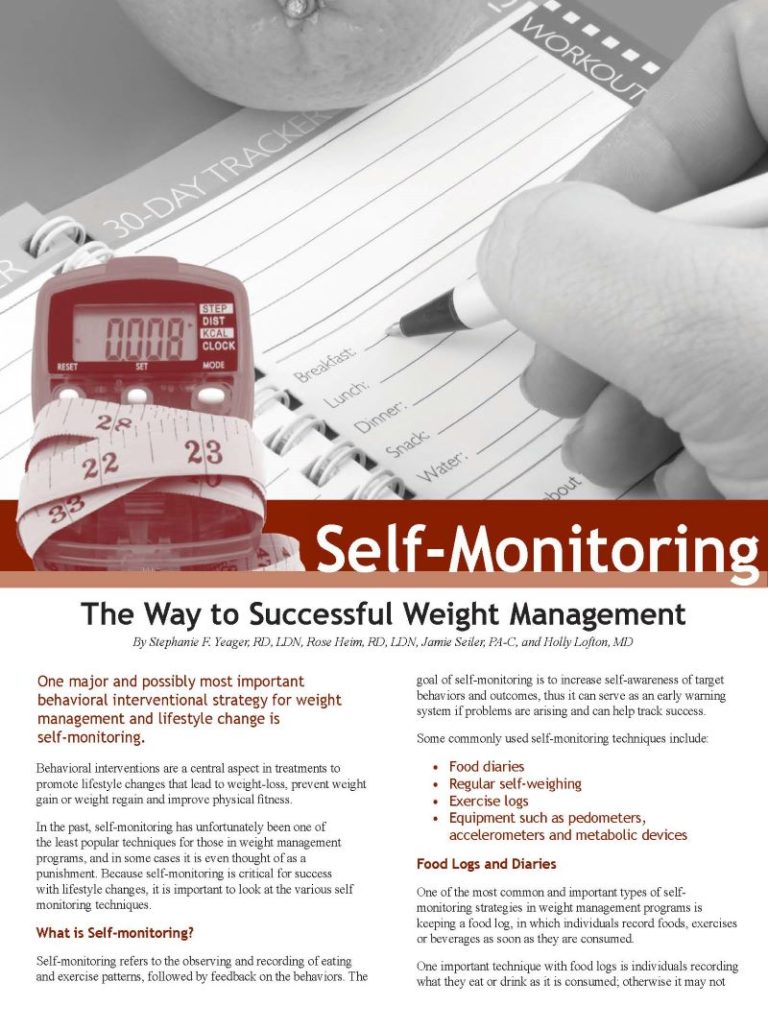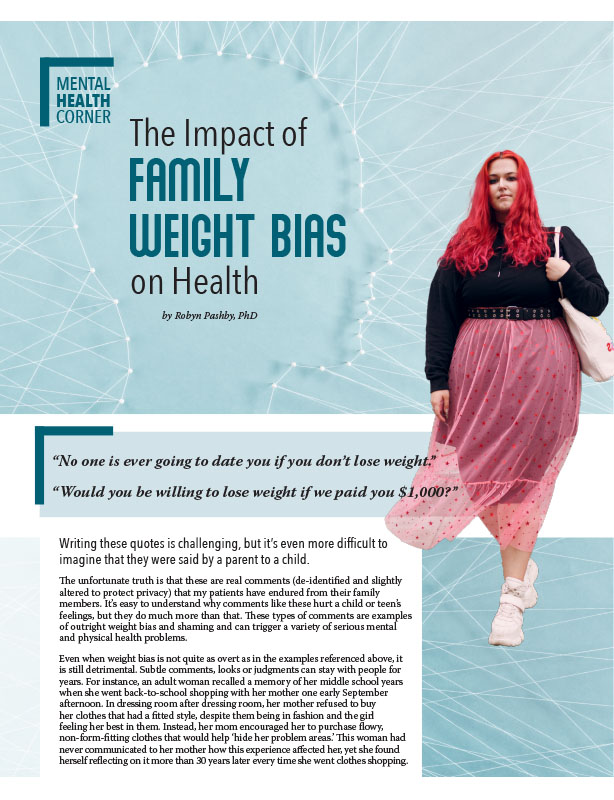Self-Monitoring – The Way to Successful Weight Management


By Stephanie F. Yeager, RD, LDN, Rose Heim, RD, LDN, Jamie Seiler, PA-C, and Holly Lofton, MD
Winter 2008
One major and possibly most important behavioral interventional strategy for weight management and lifestyle change is self-monitoring. Behavioral interventions are a central aspect in treatments to promote lifestyle changes that lead to weight-loss, prevent weight gain or weight regain and improve physical fitness. In the past, self-monitoring has unfortunately been one of the least popular techniques for those in weight management programs, and in some cases it is even thought of as a punishment. Because self-monitoring is critical for success with lifestyle changes, it is important to look at the various self monitoring techniques.
What is Self-monitoring?
Self-monitoring refers to the observing and recording of eating and exercise patterns, followed by feedback on the behaviors. The goal of self-monitoring is to increase self-awareness of target behaviors and outcomes, thus it can serve as an early warning system if problems are arising and can help track success. Some commonly used self-monitoring techniques include:
- Food diaries
- Regular self-weighing
- Exercise logs
- Equipment such as pedometers, accelerometers and metabolic devices
Food Logs and Diaries
One of the most common and important types of self-monitoring strategies in weight management programs is keeping a food log, in which individuals record foods, exercises or beverages as soon as they are consumed.
One important technique with food logs is individuals recording what they eat or drink as it is consumed; otherwise it may not give an accurate account of the day’s intake. A good “rule of thumb” for food logs is: “if you bite it, you write it!”
The minimum information for weight-loss that should be kept in food logs is type, amount and caloric content of food or beverage consumed. This provides the ability to track and balance the number of calories consumed throughout the day with the amount of calories expended throughout the day.
Other nutritional information that can be logged includes: time of day of eating, fat content and carbohydrate grams. Disease-specific food logs can also be kept. For example: focusing on carbohydrate content instead of calories for patients with diabetes or insulin resistance.
Food Diaries
Another helpful tool in self-monitoring is keeping a food diary. Food diaries differ from food logs because they include more detailed information. They are useful if you are trying to find behavioral reasons or psychological aspects for eating.
Depending on the person and behavioral complexities involved, some food diaries could include the stress level, mood or feelings surrounding eating, activity or location or other environmental or emotional triggers for eating. The more complex or detailed, the better the feedback.
However, in today’s society it is almost impossible for most people to keep highly detailed daily food records over the long-term, therefore, compliance is often very low with detailed food diaries. By suggesting that patients keep a detailed food record for a few days each week, perhaps major areas of focus for nutritional and behavioral intervention can be recognized.
Logging Your Food Online
Online food logs and diaries or computer software are quick and convenient ways to keep records of foods consumed in our technologically advanced world. Many Web sites are available for tracking of foods and calories throughout the day, some of which are free and very easy to use.
You can look up food choices and/or alternative choices in online databases of more than 50,000 foods. Internet-savvy loggers may choose to keep their journals online. Others may just choose to use these databases as a more convenient way of looking up nutritional value of foods. Some free online diaries include:
Free Web sites for searching nutritional information are available, an example is www.calorieking.com. These Web sites may also offer exercise tracking and ideas, support, motivational tips and chat or discussion rooms.
Hand-held Calorie Counters
Another option for those who are “on the go” are handheld devices for calorie counting. Some of the devices are stand-alone such as CalorieSmart® or HealthFitCounter®. Others need to connect to Web sites. Other devices are installed in your Palm or Pocket-PC such as Diet Diary by Calorie King. They let you download updates when nutrition facts change, however, some of them use a lot of memory.
Regular Weighing
Weighing yourself is an important and simple self-monitoring behavior to serve as reminder of one’s eating and physical activity habits. Although it may be hard and sometimes discouraging to weigh yourself while losing weight, it is recommended to weigh yourself weekly, preferably outside of the home on the same scale.
Using the scale at the local gym or exercise facility or your doctor’s office may be more accurate than home scales. However, if this is unrealistic, it is okay to use a home scale. Try to weigh yourself at the same time of day and the same day of the week.
Writing down your weekly weights on a table, graph or calendar can help you keep track of your success or to help you get back on track more quickly. It is important to note that weighing yourself more frequently than weekly is not recommended, as day to day fluctuations are not indicators of actual weight. Regular monitoring of your weight is also essential to help you maintain your weight after losing weight.
Exercise Logs
Another self-monitoring technique, along the same lines as food logs and diaries, is keeping an exercise log or diary. The number of minutes engaged and type and level of exertion of physical activity should ideally be recorded.
An important and often forgotten aspect of exercise logs is the level of perceived exertion. Walking for 30 minutes, at an easy compared to a hard pace, will result in different levels of calories burned and cardiovascular impact.
Typically, an easy physical activity that does not increase heart rate much, or alter breathing would usually be the pace that you walk around work or go shopping. Moderate level of physical exertion is when you are getting a mildly increased heart and breathing rate. Heavy or hard level of physical exertion would be sweating, increased heart rate (target heart rate range) as well as increased breathing.
Remember, physical activity can be done at one time or intermittently throughout the day. Logging exercise can be a positive feedback or a reminder to incorporate more exercise or physical activity into your daily routine.
Initial activities may be walking, riding a stationary bike or swimming at a slow pace. Other types of exercise that can be fun are dancing, exercise videos or chair exercises. You should try to aim for 30 minutes of exercise on most days of the week.
Many people try to start out with exercise on three or four days of the week. However, if you can get yourself exercising most to all days of the week, even if only for 10 or 15 minutes, it will become more of a routine for you.
Healthy Lifestyle Tip
All adults should set a long-term goal to accumulate at least 30 minutes or more of moderate-intensity physical activity on most to all days of the week. Also, try to increase activities of daily living such as taking the stairs instead of the elevator, parking further away or walking to a bathroom that is further from your desk. Reducing sedentary time is a good strategy to increase activity by undertaking frequent, less strenuous activities. With time, you may be able to engage in more strenuous activities.
Pedometers
Self-monitoring tools are becoming more and more popular and accurate. One of the simplest of these self-monitoring tools is a pedometer. Pedometers give objective data of physical activity throughout the day. Pedometers can be found in almost any consumer catalog or retail store.
Some of the more popular manufactures include Digi-Walker, Omron, Acumen, Bodytrend, Oregon Scientific, Sportline, Freestyle, Brookstone, AccuStep and many others. Garmin and Timex make pedometer of speedometer devices that calculate steps and speed using GPS. These clip-on devices are inexpensive, ranging from less than $15 up to $75.
Many people get an average of 3,000 steps per day with daily activity. In order to burn off extra calories for weight-loss, walking 10,000 steps per day is recommended. For regular health, a minimum of 6,000 steps per day is required. Research suggests that a deliberate walk of 4,000-6,000 steps will help with weight-loss. It is often a good idea to keep track of your daily steps taken in your exercise log.
Pedometers can be frustrating for those who are more interested in distance traveled. Focusing on the number of steps and ways to incorporate more steps throughout the day will make as much of a difference with weight-loss as actual distance does. Pedometers encourage people to find ways to add more steps throughout the day.
Because step counting is becoming more popular, advances are being made in the technology behind pedometers. New pedometers display steps and count them accurately. They are meant to be worn everyday and all day, as motivation to keep stepping, Most are small and comfortable to wear.
Pedometers sense your body motion, counting your footsteps usually by a turned pendulum technology, a coiled spring mechanism and a hairspring mechanism (which is the least accurate). The unit should be accurate in its count when you wear it correctly. You may need to experiment with where to wear it. You can measure your stride and then the pedometer can estimate distance traveled.
Some pedometers today offer multifunction options like calorie estimates, clocks, timers, stopwatches, speed estimators, seven-day memory or pulse rate readers, voice feedback and radios.
Accelerometers
Although pedometers are very cost-effective, one of the main flaws in using pedometers, however, is that they do not record intensity (how hard) or duration (how long) or frequency (how often) movement occurs. Accelerometers are devices that can objectively measure frequency, duration and intensity of physical activity.
Accelerometers provide a high level of accuracy when assessing physical activity. There are a variety of commercially available accelerometers, or activity monitors, which come in a wide range of prices anywhere from $50 to $1,000. BioTrainer and Nike are examples of affordable accelerometers.
Many of the more expensive accelerometers are used only in research or as a part of a hospital-based program. These monitors are more complex than pedometers in that they display and store more complex data. Some are designed to download to a computer for analysis of intensity levels, movements and physical activity patterns. They can also be used to estimate calories burned or energy expenditure.
Accelerometers have sophisticated sensors that convert physical movement into an electrical signal that is relative to the muscular force needed to produce the work. Accelerometers can be found in uniaxial or triaxial measures. Uniaxial accelerometers measure in a single plane and can be attached to the trunk or limbs. Triaxial accelerometers measure along three planes: vertical, medial-lateral and anterior-posterior.
Although accelerometers are a step up from pedometers in accuracy of physical activity, they cannot register resistance. Therefore, if you are strength training or adding resistance to your bike or treadmill or adding an incline to your walking, it will not be able to discern the added level of energy required to do that work.
Metabolic Devices
One of the most accurate and most expensive tools for self-monitoring are tools that have very sophisticated monitoring and interpreting sensors for calories burned. Many of these devices have options to subscribe to a Web-based calorie counter system that integrates the amount of calories burned measured by the equipment and your calories consumed that you enter in easy to use food logs.
These devices are more accurate in measurements of calories expended because they use not only accelerometer technology, but also heat flux sensors, galvanic skin response (to measure physical exertion and emotional stimuli) and skin temperature gauges. Some also include heart rate monitoring techniques. All of these technologies combined lead to a very accurate measurement of calories expended throughout the day.
These devices can determine if you are sitting, sleeping, jogging, walking, lifting weights or riding in a car. Many of these devices are very expensive and used primarily for research, however, some are available commercially.
This technology is also employed by hospital-based programs. Patients wear the hospital’s armband and track their nutrition on the Web site or computer-based program for typically one to two weeks. When they return to the clinic, the information will be uploaded and the practitioners will be able to work with the patients with objective data on metabolic lifestyle patterns.
Practitioners can also monitor patients on integrated software applications to provide consultations without being face to face. Practitioners have the ability to set daily goals to tailor programs to the individual patient. These are great tools to help objectively monitor behavior and physical activity, as well as providing real time feed back to the patient. SenseWear® is one company that offers this technology.
Conclusion
Although specific diseases and treatments vary, behavior modification is the major key in weight-loss or prevention and decreases the risk of diseases. Self-monitoring is a key to behavior modifications, and there are a multitude of ways to self-monitor. With technology advancements, self-monitoring techniques are changing and improving to help defeat some of the major barriers to compliance. The bottom line is that no matter how you do it, self-monitoring should be an important part of your weight-loss, weight maintenance or healthy lifestyle change. Then, the next step is to be sure the self-monitoring translates into positive behavior changes with regards to diet and exercise.
About the Authors:
Stephanie F. Yeager, RD, LDN, has been with the Center for Nutrition and Weight Management at Geisinger Health System since 2002. She completed her Bachelor’s in Nutritional Sciences and Exercise Physiology at Penn State University in 2002 and her Dietetic Internship at Geisinger Medical Center in 2004. Stephanie is actively involved in multiple research studies on obesity and has authored and co-authored research publications and book chapters on topics such as behavior modification and outcome evaluation of vitamin and mineral requirements, genetics, metabolism and quality of life after bariatric surgery.
Rose Heim, RD, LDN, works for the Center for Nutrition and Weight Management at Geisinger Medical Center.
Jamie L Seiler, MPAS, PA-C, has been with the Center for Nutrition and Weight Management at Geisinger Health System since 2007. She completed her Bachelor’s of Science in Biology at Lycoming College in 2003 and her Master’s in Physician Assistant Studies at Marywood University in 2006.
Holly F Lofton, MD, is currently a fellow in the Bariatric Medicine/ Nutrition program at Geisinger Medical Center under the direction of OAC Board of Director Christopher Still, DO. Her primary interests are improving nutrition and activity profiles for patients with excess weight or obesity and educating the public on the importance of preventing obesity.
by Kendall Griffey, OAC Communications Manager Spring 2024 We have officially kicked off Your Weight Matters Regional…
Read Articleby Robyn Pashby, PhD Winter 2024 “No one is ever going to date you if you don’t…
Read Articleby Kendall Griffey, OAC Communications Coordinator Winter 2024 The Obesity Action Coalition’s 12th annual Your Weight Matters…
Read Article








